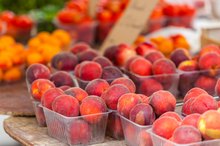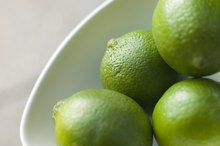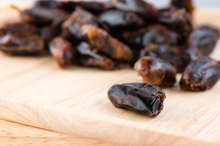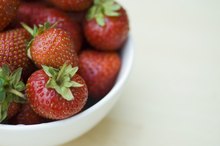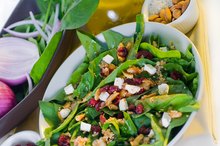Fruits That Do Not Contain Folate
Fruits are ordinarily an excellent source of folate, which is the natural equivalent of folic acid found in foods. When you combine ample fruits with vegetables in your daily diet, you can meet up to a third of your folate needs. Ohio State University reports that fruits qualify as a good source of folate if they provide 10 percent or more of the US Recommended Daily Allowance based on a 2,000 calorie per day diet 1. If you do not meet your body’s requirement for folate, a kind of anemia can result. The recommended intake of folate is 400 micrograms for adults, 600 micrograms if you are pregnant and 500 micrograms if you are nursing.
Apples
Although apples are a good source of dietary fiber and vitamin C, apple slices with the skin removed supply no folate in a one cup serving. If you don’t peel the fruit, you’ll get 4 micrograms for the same serving, but this is still only 1 percent of the US Recommended Daily Allowance.
Cranberries
Fruit with Beta-Carotene
Learn More
A cup of raw cranberries has 1 microgram of folate, but this provides zero percent of the US Recommended Daily Allowance for a 2,000 calorie per day diet. Cranberry juice, with a higher concentration of berries per serving, has 3 micrograms of folate, but this is still only 1 percent of the Recommended Daily Allowance.
Fruits That Do Not Meet RDA Requirements
Some fruits contain folate in such small amounts that they provide only 1 percent of your daily requirement on a 2,000 calorie per day diet and thus fall grossly short of the RDA’s requirements. A one cup serving of sweet cherries or watermelon balls provides only 1 percent of your daily requirement. One average-sized kumquat provides only 3 micrograms of folate. The same serving size of either red or green grapes has only 3.0 micrograms. A lime has 5 micrograms but this is still only 1 percent of your daily allowance. One average-sized quince has 3 micrograms of folate. Apricots and pears contain slightly more folate per serving at 3 percent of RDA.
- Some fruits contain folate in such small amounts that they provide only 1 percent of your daily requirement on a 2,000 calorie per day diet and thus fall grossly short of the RDA’s requirements.
- One average-sized quince has 3 micrograms of folate.
Related Articles
References
Writer Bio
Beverly Bird has been writing professionally since 1983. She is the author of several novels including the bestselling "Comes the Rain" and "With Every Breath." Bird also has extensive experience as a paralegal, primarily in the areas of divorce and family law, bankruptcy and estate law. She covers many legal topics in her articles.
